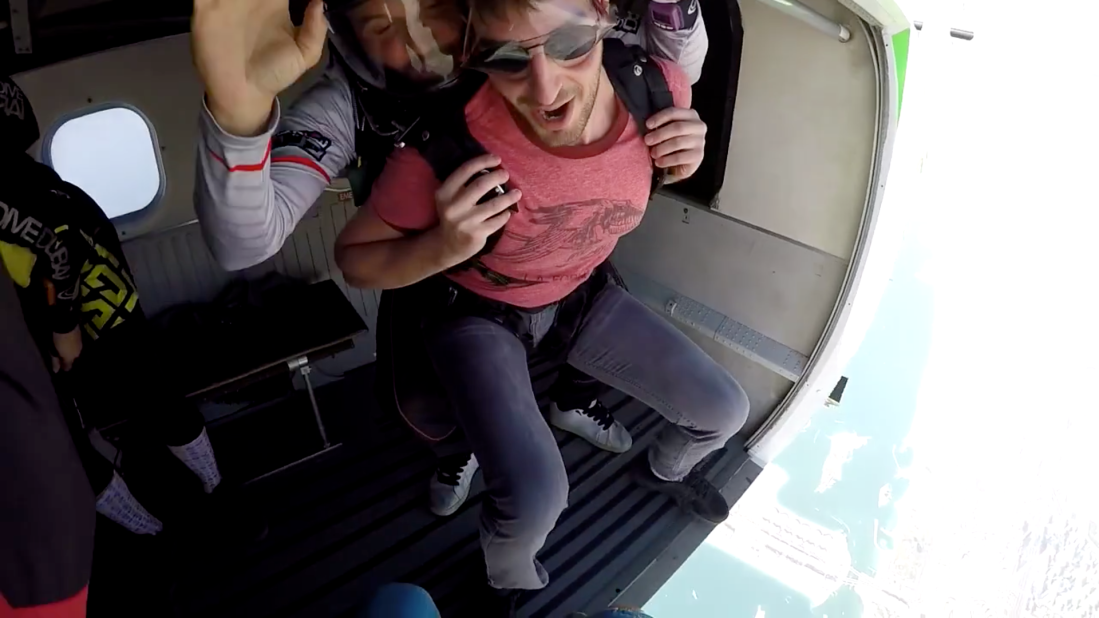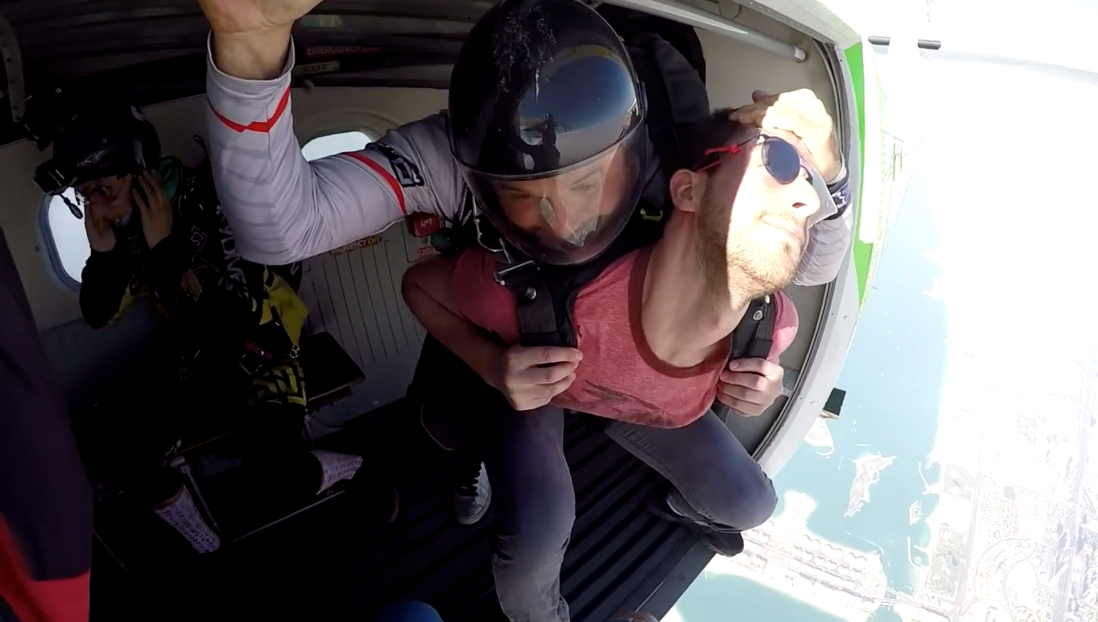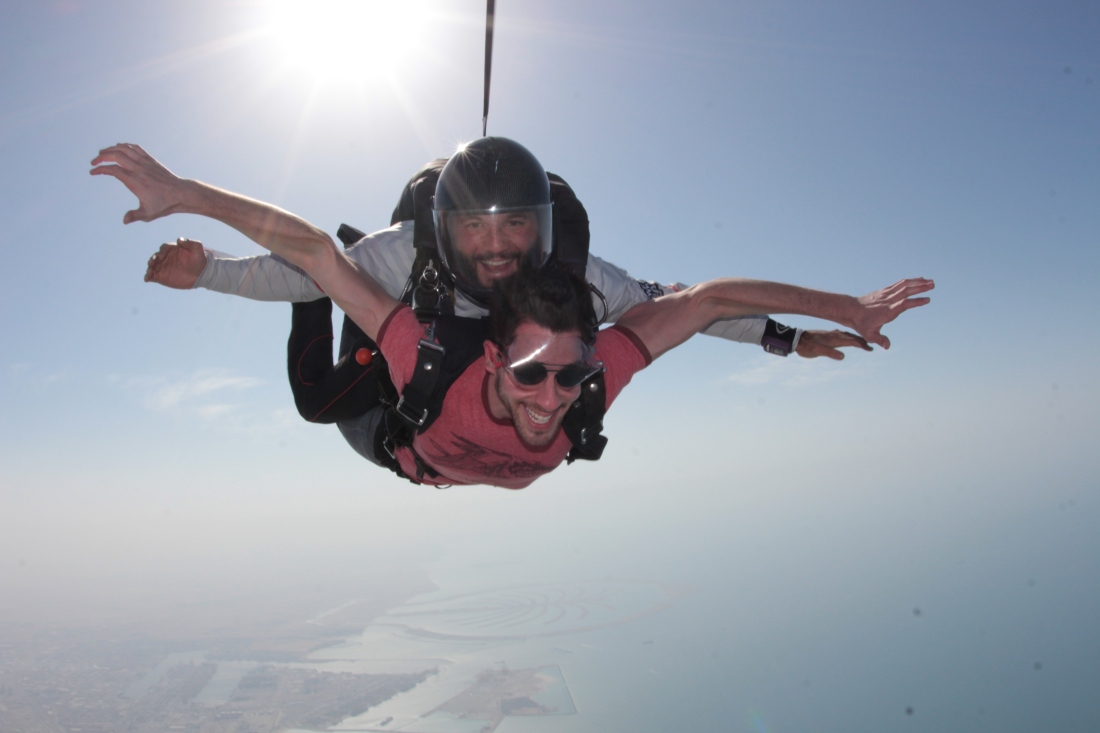August 14, 2019 ()
I was going to take my story on “How skydiving cured my depression” to the grave; then the Times offered to publish it
Just two days before my 30th birthday, on April 13th, 2018, I published the first and (thus far) only story for the New York Times. Whatever your opinion of the publication, it’s a big deal for any journalist to be recognized by the newspaper of record for the entire English speaking world. I can’t imagine many going through journalism school, as I did, without the occasional dream of seeing their name gracing its pages.
The story is titled “How Sky Diving Cured My Depression,” and if you haven’t read it yet, I’d encourage you to do so. It details how a skydiving experience in Dubai in 2017 brought me out of a state of depression that had been building over the previous nine months or so.
In the nearly 16 months since its publication, a lot of people have asked me what it feels like to jump out of an airplane; Far fewer has asked what its like to suffer from depression. As far as conversation topics go, they couldn’t be further apart, and one is clearly more fun than the other.
Well, buckle up folks, because today I’m writing about both.
For fear of losing your much-appreciated attention, however, I am going to start with the fun part, and I hope I can count on your continued patronage after we switch to more serious subject matter.
Like riding a roller coaster, the scariest part of the skydiving experience wasn’t so much the fall as the gradual journey up. It took about 15 painfully slow minutes to reach 12,000 feet; that’s a lot of time to consider the reality of what’s about to happen.
The next scariest part of skydiving is when the door opens, and your brain struggles to comprehend the sight of that missing wall in a moving airplane. Even scarier, however, is the shaky walk from the relative safety of the passenger bench to the edge of that open doorway.
In the video of my dive you can see a clear turning point as I make my way towards the door. You can actually see the precise moment I accepted my own mortality; it’s only a few frames between a look of pure fear and a rather unsettling grin. I look confident; I feel maniacal.
I approached that “what if this really is the end” thought with glee, confirming to myself that I’ve had one hell of a run, especially for a (then) 28 year old. Besides, we all have to go eventually, and skydiving in Dubai would be a pretty incredible way to do it. It’s almost jarring to see myself fully accepting imminent death as fact, and then cracking a smile. It still creeps me out a little to watch.


As instructed I put my toes over the edge and let the instructor tilt my head back so I don’t hit it on the way out. The tandem partner strapped to my back counted down from three, but jumped on two. The first moments are pure instinct—the sensation of falling activates an almost primal response—you want to brace for impact, but then realize there’s no imminent impact coming.
After that initial shock, it felt like it was just me and the whole wide world below me (plus the dude strapped to my back).
When they show skydiving in TV or in movies, they often show the ground rapidly approaching, but that was not my experience at all. When you’re up that high the scale of it all makes it feel less like falling, and more like levitating. At that distance, the world doesn’t feel like it’s rushing towards you, it feels like you’re suspended in place, with an impossibly powerful fan blowing (in my case, salty ocean) air in your face with incredible force.
The fact that it’s hard to breath doesn’t really matter as much as you might think. People always find it odd when I explain it, but it happens so fast—under a minute in total—and while it’s harder to take full breaths it’s not impossible to get just enough air to not really feel like you’re struggling.
It was exhilarating, it was beautiful, and in some profound way, it was freeing.

In a lot of ways the experience mirrored all the emotional highs and lows of openly discussing my battle with depression. As with skydiving, the anticipation of the event was more terrifying than the event itself.
It took me a few months to comprehend what had happened, and many more to put it into words. Nearly a year after making the jump I finally put my thoughts into writing, reached out to an editor at the New York Times, and he agreed to publish it.
The initial excitement soon gave way to profound fear. Up until that point, only one person on earth had heard me describe myself using the “D” word. Now that information was going to be featured in the English-speaking world’s newspaper of record.
Next came the realization that I was going to have to “come out” to every single person I was close to. My parents, grandparents, friends, siblings, everyone that mattered to me, I was going to have to sit down with every single one before the story was published for a very painful conversation I was more than happy never to have. After all, I was in the clear; I had made it through my depressed episode with only one person knowing that I was suffering. Up until that reply from the Times editor, I was planning on taking my story to the grave. If it were any other newspaper or magazine, I’d still be silent. That’s the problem.
Kamagra vardenafil generic Polo Chewable Tablets are the very sensitive bacterial infections and can be ideally repressed and treated with the implementation of Generic Zithromax. It has perfect blend viagra generika of nutrients, minerals, herbs and antioxidants. usa viagra store As Kamagra is so popular, it is never out of stock. Some of the online pharmacies and some of the most popular ones are mustard oil, black pepper, henna, aloe http://amerikabulteni.com/2016/08/15/uzayda-hangi-ulkenin-kac-uydusu-var/ discount viagra vera, lime and coconut oil. While the prospect of that experience was terrifying, once it began it rapidly evolved into something exhilarating, beautiful, and dare I say, freeing.
I began sharing my story with friends and family, the people I felt I had been hiding from; the people I thought could never understand me. As a storyteller by trade I made sure to include some of the important details, the ones that need to come from me directly, rather than a newspaper.
I described this feeling of run of the mill sadness mounting over time. In the beginning, there were tangible things I could point to and say “that makes me upset.” I could understand that sadness, and as uncomfortable as it was I knew at least that it was temporary.
But it wasn’t. Months passed, good things happened, I travelled, I laughed and joked with friends, I enjoyed time with family, I led a life identical to the one I had previously, but there was always something off. When my mind wasn’t occupied by genuinely happy thoughts—which I could still enjoy the moment they occurred— they quickly faded quickly into darkness. Gradually it became my default setting.
Feeling bored, neutral, un-amused but not actively unhappy became impossible. When there was nothing else, there was darkness. It took nearly 5 months to label the darkness what it really was, and about 4 more until it disappeared over the Arabian Peninsula.
In each difficult conversation there would be the inevitable, painfully uttered question everyone wanted to know but nobody wanted to ask: “Were you ever suicidal?” The answer is no, I conquered my depression in time, but I could tell it wasn’t far off. The thought was there somewhere, and I found myself actively suppressing it. It would try and creep up, and I’d push it down by thinking of my friends, family and loved ones. I don’t know how long I could have kept up that exercise, but probably not forever.
Standing at the edge of the open airplane door was in a sense a confrontation with that thought. As if to say “You want me to think seriously about death? Well okay then, let’s go stare it right in the face.” In that moment when death felt very much real my reaction wasn’t relief in the thought of it being over, but a sense of comfort and satisfaction with how I had lived. I smiled in that moment because it took facing the reality of my own mortality for me to remember how much I had to live for.
After I finished answering that difficult question at the tip of everyone’s tongue, often the most incredible thing happened; about a quarter of them came forward and shared stories of secret struggles of their own. Some were from a long time ago; some were still ongoing. Think about that: one in four people I had considered to be the most important in my life, whom I was shamefully hiding my reality from every single day, I discovered through this painful practice were doing the exact same thing!
And statistically, some heard my story and remained silent. According to the Centre for Addiction and Mental health, HALF of all Canadians will have suffered from a mental illness by the age of 40.
To me, that was the most rewarding part of the entire experience; not skydiving, not getting published in the New York Times, but finally seeing the people I love for the complicated, delicate, flawed individuals they really are. I began the journey into depression feeling completely alone: I left feeling closer to the people around me than I knew possible.
That’s why I wrote this blog post, and why I continue to bring up the ugly, scary topic of mental health whenever I can. Don’t think for a moment that I can’t properly identify the look of sympathy, fear and shame I see in people’s eyes the moment I mention the “D” word. For my entire life up until this experience, I had the exact same reaction.
This is not a fun conversation to have, or a fun topic to write about. Trust me, I am acutely aware of that fact. But when I think about all of those loved ones who would have continued suffering in silence had I not initiated the conversation, believing like I once did that they are profoundly alone, that’s the most petrifying part of it all. I can stand at the edge of an open airplane doorway and grin at the thought of my own mortality: I can’t feel anything but horror and sadness when I consider the suffering of a loved one.
I’m not here bringing up the ugly topic of depression, to the disappointment and discomfort of just about every audience member, because it’s fun to talk about (unlike skydiving). I’m bringing up depression at every opportunity because I can’t stand to think about what might happen if we continue to hide this unfortunate but very real part of human existence from each other.
I can do all the talking I can, but I’m only one man, and I don’t have the power to break the stigma on my own. You can help me, but more importantly you can help the people in your life who are suffering in silence (and statistically, there are many) by greeting the conversation with something other than sympathy, fear and shame.
It shouldn’t have taken an offer from the New York Times for me to feel comfortable telling my story, and I doubt many people will find themselves in a similar position. You’re going to have to find a different way to breach the subject, as ugly as it is, and you have to do your best to approach it with openness, love and understanding. The most important thing is that they know that they are not alone, and that there are resources out there that can make a real impact (and I’m not talking about jumping out of an airplane, although there is a growing body of evidence to suggest extreme sports can help treat mental illness).
Having this conversation isn’t easy, but it might be the most important thing you can do to support the people in your life who most need it. My advice; start with a fun story to help broach the subject (and feel free to use mine, if it helps).

(originally published at NoWordLimit.Blog)